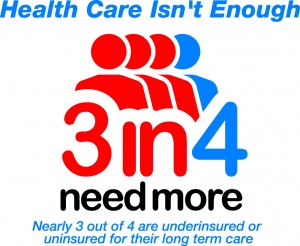One of the most daunting  risks faced by those over 60 is the cost of long-term-care. And hey – if you’re far from 60 – don’t skip this article – it includes you!
risks faced by those over 60 is the cost of long-term-care. And hey – if you’re far from 60 – don’t skip this article – it includes you!
Experts say 70% of us will need some form of long-term care – and not necessarily the “end-of-life” kind we tend to think of. It could be the result of a heart attack, cancer, stroke, diabetes (in-home care), Alzheimer’s (cognitive impairment), or a debilitating disease or injury.
As a result, traditional long-term-care is going the way of the dinosaur. Only a handful of companies still offer it – and the cost is going through the roof – assuming you can even get coverage.
The good news is that many of today’s life insurance policies include a feature called an “accelerated death benefit” that allows you to access a portion of the death benefit for a qualifying long-term-care need. Generally, “qualifying” means the inability to perform 2 of the 6 ADL’s (activities of daily living).
This benefit is available on many permanent and term life policies. It’s usually a free feature because the insurance company simply “advances” a portion of the death benefit at a discount. That “discount” means they “charge” for the rider only when/if it is needed. To you and I – it’s like being able to buy the insurance after we’ve already wrecked the car.
What’s more, these are “indemnity” plans – meaning you can access the money and spend it any way you wish. If you have a child, friend, or neighbor who can care for you – but is not a licensed care-provider, you can pay them from the cash sent to you from the insurance company. Maybe they deliver care while on a cruise – paid for from the insurance benefit!
Because life insurance is issued based on the insurance company’s assessment of your likelihood of dying (mortality risk), they ignore the very risk long-term-care providers assess – the risk you’ll need to access the LTC benefit (morbidity).
So as life expectancies continue to grow, life insurance becomes less expensive. Therefore, policies that feature these benefits are a very inexpensive way for you to fill the long-term-care gap in your overall risk management/insurance plan.
If you haven’t “shopped” your life insurance lately – do it now. If you don’t have life insurance (shame on you), check it out – but look for the kind that offers “living” benefits in addition to the traditional death benefit.





